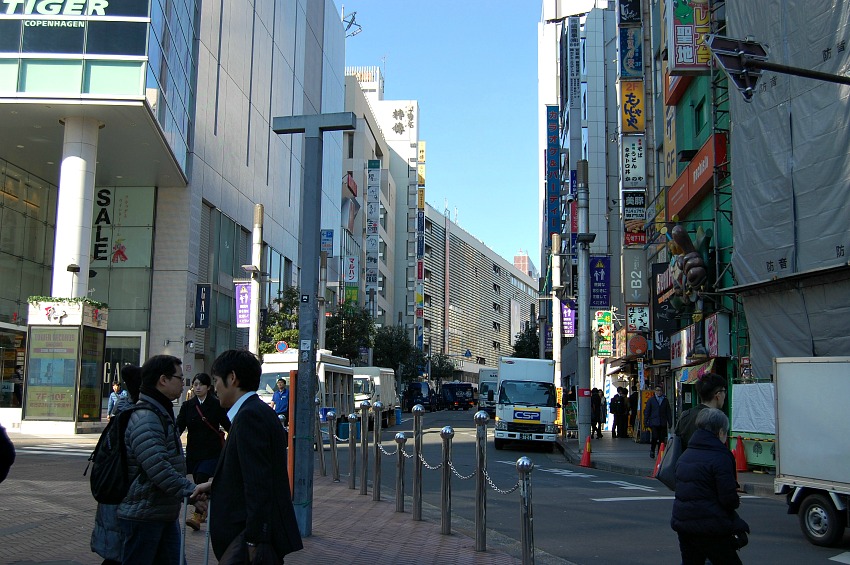南口を出て京王デパート近辺にあるビルで用事を済ませ、角筈に出て伊勢丹の方まで歩き、花園神社に寄ってお正月の松飾りの処分をして頂くために神社に納めてきた。うちの近所の神社に持参してもよかったのですが、小さな神社なのでいつ行っても人が誰もいない。らちが明かないので、新宿の有名神社なら大丈夫だろうと思い、用事ついでに松飾を持って行きました。
新宿駅を出ると、とにかく外国人観光客が多くてびっくり。あちこちから外国語が聞こえてくる。特に多かったのは中国語でしたね。
観光バスから中国人観光客がぞろぞろと降りてくる光景も見ました。これが爆買いで有名なひとたちかぁ・・と。(笑)
Two months ago, I went to Shinjuku on some errands.
I familiar with the town because I was born in Shibuya Ward, the next town to Shinjuku. I
live in the suburbs of Tokyo now.
After coming out of the south exit of the Shinjuku station, Koshu-Kaido(甲州街道) appears right in front. Many people coming and going there. Koshu-Kaido was one of the five routes of the Edo period and it was built to connect Edo (modern-day Tokyo) with Kai Province in modern-day Yamanashi Prefecture, Japan.
Perhaps a scenery of radical change in Shinjuku since my child hood is a lot of foreign tourists on the road. I could see non-Japanese people from different countries enjoying travelling here.
Japan has been easy to met with misunderstanding from the rest of the world because of its unique culture and the geographical isolated condition of being surrounded by sea. So I think it is acceptable that many foreigners come to Japan and know and understand about Japan more deeply.
南口を降りて目の前は甲州街道。たまたま撮ったこの写真にもすでに西洋人系の人たちがたくさん写りこんでいますね。つまりかなり多いということでしょう。
In front of the south exit of the Shinjuku Station.
新宿駅ルミネ口というのでしょうか。小奇麗な広場。こんなの昔はなかった。確かこの辺は小さな飲み屋さんが集まってたんじゃなかったかな。
Rumine Exit Square near the south exit of the station.
Rumine Exit Square.
ルミネ口から出てここをまっすぐ行くと駅の東口方面。
We can see the east exit of the Shinjuku station at the back of the road.
東口駅前、スタジオ・アルタ。昔このへんにたしか二幸という食料品ばかり売ってるデパートがありました。
In front of the east exit. The building with a big display is Studio Alta. A popular TV show called "Waratte iitomo" is broadcast from here everyday. "Waratte iitomo"means "You can laugh freely" The program now holds the record for live variety show that has been broadcast most frequently with the same host.
ここまっすぐ行くと、画材屋さんの世界堂とかを左手に見つつ明治通りに出る??ああ、わからない(笑)とりあえず明治通りに出て伊勢丹の向こう、靖国通りにある花園神社に行こうとしているところです。
There should be Meiji Dori (明治通り) up ahead.
明治通り。左手が伊勢丹で(昔のまま)、交差点の手前右に飴屋の老舗榮太郎やヤマハ楽器があったような。今もあるのかな。新宿は大通りや大きな施設や建物の位置は殆ど変らないが、全体がやはり今風に小奇麗に様変わり。
This is Meiji Dori. Meiji Dori is a very old and important street in the history of Tokyo.
It cuts through Shinjuku on the east side of Shinjuku Station, bisecting Yasukuni Dori and passing through Shinjuku sanchome (新宿3丁目) near the Shinjuku Sanchome Station.
伊勢丹。私の生家は新宿と渋谷の境あたりにあったので、伊勢丹、三越あたりへは歩いて買い物にきたものです。
Isetan's department store. The store has been in business in 130 years. I would come around here for shopping by foot when I lived in Shibuya Ward.
西口の明治安田生命ビルの後ろにある変わった形の建物が、モード学園コクーン(繭)タワー。「創造する若者を包み込み、触発させる」という意味を込めて、「繭」の形なんだそうです。大空に聳え立つこのビル、美しいです。現在3つの専門学校が入っていて1万人の学生が通ってるんだとか。
In front of the west exit of Shinjuku station stands a web-like building called Mode Gakuen Cocoon Tower. Mode Gakuen is a fashion and art vocational school attended by ten thousand students. It looks so beautiful! The "cocoon" in the building's name is derived from the image of a kind of womb that wraps up the students, lets them inspire each other, and helps them grow as creative artists, just like a cocoon wrapping a pupa.
One of the purposes of my visit to Shinjuku was to dispose a pine decoration which was displayed for this New Year. After use, a pine decoration is generally dedicated to the shrine to be burned in the celemony named "Dondo-yaki" So I was here, Hanazono Shrine in Shinjku.
お宮参りカップルの拡大図。
Enlarged view of the Omiyamairi couple with their baby
The father has his baby in his arms. The red small kimono
is baby's festive dress.
本殿の前。右端の二人連れは赤ちゃんのお宮参りに来たご夫婦でしょう。右側の赤ちゃんを抱いているのがお父さん、隣がお母さん。二人を見守る婆ちゃん、写真を撮っているのがおじいちゃんだと思います。
お宮参りというのは、生後30日くらいに、生まれた赤ちゃんと一緒に神社に赴いて、土地の守り神に赤ちゃんの誕生を報告し、健やかな成長を願う行事です。ちょっとキリスト教の洗礼に似てませんか?まあ日本のお宮参りは一つの風習のようなもので、あまり宗教色はないのですが。
Main hall of the shrine. A small group on the right side of the picture may be an Omiyamairi party. Omiyamairi (お宮参り) is a Japanese traditional custom in which parents bring their new-born baby to a local shrine to introduce him or her to the guardian deity and pray for the baby's healthy growth. Usually practiced about one month after birth, with the father's mother accompanying them. It is a little bit similar to Christian baptism, but rather secular, I think.
境内には若い人たちが参拝する姿も結構見られました。
近年になって、周辺国との歴史問題でのいざこざが伝えられていますが、それが却って日本の若者たちの愛国心に火をつけたようなところもありますね。靖国神社でも若い参拝客が多かったです。
これが今年わが家で飾った松飾り。綺麗でしょ。
This is the pine decoration displayed above the front door of my house on New Year's Holidays. Isn't it beautiful?
(camera, Nikon D40, Lumix GF1)
[過去記事]
どアップシリーズ引き続き試し撮り
新しいレンズが届いたので
うちの植物たち
庭もブログもリニューアル
My group planting for the first time初めての寄せ植え
My cat, evil-looking as everふてくされニャンコの近影
I went to Yasukuni shrine 靖国神社に行ってみた
Try out Nikon D40
The season for taking pictures
Angel? or Devil? 天使か悪魔か?
My cat again
My cat with fearless eyes 不敵な面構えの猫
Edo-Tokyo open air architectual museum l江戸東京たてもの園
I bought a new camera, sony RX100
some celestial phenomena yesterday
It's snowing in Tokyo
Pet cemetery
My home town













